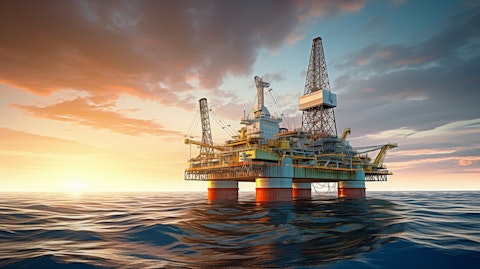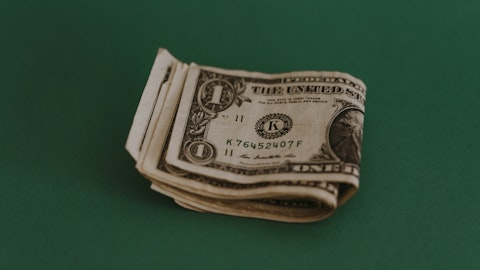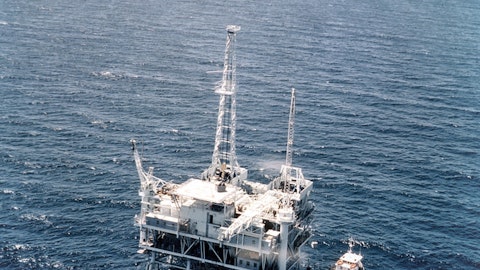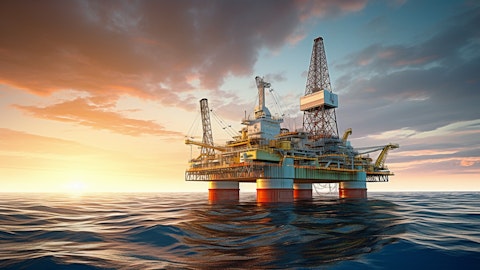Borr Drilling Limited (NYSE:BORR) Q4 2023 Earnings Call Transcript February 22, 2024
Borr Drilling Limited reports earnings inline with expectations. Reported EPS is $0.11 EPS, expectations were $0.11. Borr Drilling Limited isn’t one of the 30 most popular stocks among hedge funds at the end of the third quarter (see the details here).
Patrick Schorn: Good morning, good afternoon, and thank you for participating in the Borr Drilling fourth quarter 2023 earnings call. I’m Patrick Schorn. And with me here today is Bruno Morand, our Chief Commercial Officer; and Magnus Vaaler, our Chief Financial Officer. Next slide. First, covering the required disclaimers. I would like to remind all participants that some of the statements will be forward-looking. These matters involve risks and uncertainties that could cause actual results to differ materially from those projected in these statements. I therefore refer you to our latest public filings. Next slide. Our fourth quarter performance has been strong and we’ve closed the year having achieved several major milestones.
In the fourth quarter, revenue increased by 15% to $220 million. And our adjusted EBITDA increased to $105 million, which is 20% over previous quarter, resulting in a 48% adjusted EBITDA margin. Full-year 2023 adjusted EBITDA reached $350 million. Our backlog has grown and improved significantly in quality during 2023 where we added $728 million to our revenue at an implied average day rate of $161,000 per day. On the operational front, we have finished the year with excellent technical utilization for the quarter at 98.7% and a total recordable injury frequency of 0.65, the latter being well below the industry average. Both these numbers reflect the professionalism of our operational team who have activated rigs continuously for the last 3 years and who have successfully commenced operations in numerous new countries.
This performance has also resulted in external recognition that is dear to us. And just to name 2, our rig Saga has been awarded by Shell as global jack-up rig of the year. Also, we have received the award for the best recordable incident rate for our rig Skald and Borr Drilling as a company from the IADC Southeast Asia Chapter. On the map on the right-hand side, you see that we maintain operations in 4 main hubs, namely Mexico, West Africa, the Middle East, and Asia. This allows us to benefit from economies of scale while remaining diversified enough to provide a stable activity level. There’s been significant focus on the announcement by Saudi Aramco regarding their production targets for 2027. On this, I can only comment from a Borr Drilling perspective and based on some of the discussions we had in Saudi a week ago.
First, we have 3 rigs out of our fleet of 24 rigs working in the Kingdom, all 3 of which are multi-year contracts. Second, maintaining a production capacity of 12 million barrels per day versus 13 million barrels per day still requires a world-leading activity level and an operation second to none in size. Oil just doesn’t come out of the ground by itself, not even in Saudi. And as such, large volumes of activity will continue to be required. And in order to remain most relevant to our customer, we continue focusing on the things we can control, which is the relentless pursuit of safety and operational excellence in order to deliver value to our customers. We continue to have a very tight jack-up market. Supply has dried up and can only increase once we start to see newbuild orders coming in.
And even then, the impact will be several years out as it takes multiple years to get units built and into the market. On the demand side, Bruno will share some additional information in a minute, but also demand remains solid for the next 2 years plus. So based on our view of the business environment and a strong contracted fleet coverage, we maintain our estimate of adjusted EBITDA for the full-year 2024 to be between $500 million to $550 million. We also announced that the Board approved for Q4 as well, a dividend payment of $0.05 per share. Magnus will now step you through the financial details of the fourth quarter.
Magnus Vaaler: Thank you, Patrick. So Q4 2023 was a very good quarter financially with quarter-on-quarter increases in revenues of 15% and adjusted EBITDA increasing by 20%. We continued the sequential increase that we have had now for 8 quarters, as you can see in the graphs, and this trend of increases actually goes back even further, reflecting both that we have been putting more rigs to work and an improvement in day rates. The operating revenues for the quarter was $220.6 million, an increase of $29.1 million compared to the third quarter. This is split in an increase of day rate revenues of $24.4 million increase, primarily due to 2 more rigs starting up in the quarter and an increase of bareboat income from our Mexico joint ventures of $4.7 million, mainly related to higher economic utilization for one rig and the release of an operational cost provision.
The rig operating and maintenance expenses increased by $12.7 million or 15%, an increase that follows naturally from the increase in number of rigs increasing by 2 for the quarter. In addition, we had an increase of amortization of deferred costs of $3.8 million in the quarter. The operating income increase quarter-on-quarter was 26%. Below the operating income line, the numbers were driven by total financial expenses net of $59.1 million, which was impacted largely by one-off expenses of $8.9 million recorded related to our refinancing and repayment of all debts. The income tax expense for the fourth quarter was a credit of $9.3 million, impacted by a $16.5 million release of a valuation allowance on deferred tax assets as well as a $9.3 million release of an uncertain tax provision.
That gives us a net income for the fourth quarter of $28.4 million, an increase of $28.1 million compared to the third quarter and an adjusted EBITDA for the fourth quarter of $105.9 million, yielding a 48% EBITDA margin. Our free cash position at the end of Q4 was $102.5 million. In addition, we had undrawn RCF facility of $150 million. So in total, we have approximately $250 million of available liquidity. The cash in the quarter increased by $8.1 million, and this was affected by cash used in operating activities of $79.6 million. This number includes $99.2 million related to interest paid and approximately $10 million of income taxes paid. And this includes both cash interest incurred during the quarter and the repayment of capitalized interest on our legacy debt.
In addition, the number was impacted by cash costs related to our financing and timing differences of working capital movements. Net cash used in investing activities were $35.5 million, primarily consisting of $34 million used on jack-up additions, which is the activation cost for Hild and Arabia III and also some CapEx additions over the fleets as such and $1.3 million used on newbuild additions. The net cash provided by financing activities was $123.2 million, primarily as a result from the net proceeds of the issuance of the senior secured notes and the net proceeds from our private placement, offset by repayment of the debt. Next slide, please. Our 2023 full-year EBITDA came in at $350.5 million, and our 2024 EBITDA guidance remains in the range $500 million to $550 million.

At the midpoint of this range, this shows an increase of approximately 50% from 2023. We’re also very pleased to have completed our refinancing of all the company’s secured debt in November 2023, and we now have all our debt maturities in 2028 and 2030. The delivery installments for our 2 remaining newbuilds in 2024 are largely funded by a commitment of delivery financing by the seller in the size of $130 million per rig. And additionally, we have secured $180 million senior secured facility, which includes $150 million RCF and a $30 million guarantee facility. The refinancing provides a stable foundation for the company going forward with a fixed amortization profile that allows us to delever our debt. In addition, it also provides us the possibility of distributions to shareholders as evidenced by our implementation of a regular quarterly dividend, which we now have declared for 2 consecutive quarters of $0.05.
With this, I would like to turn the word over to Bruno.
Bruno Morand: Thanks, Magnus. Now I’d like to provide a brief update on the jack-up market and our most recent contracting and fleet developments. Jack-up utilization levels have continued to increase since our last report. In particular, the market utilization for modern rigs has now exceeded 95% in line with our earlier projections. It is noteworthy that utilization levels have continued to improve while the market absorbed a few additional newbuild rigs. Currently, the shipyard order book stands at 15 rigs, one of each has a future contract and 2 are owned by Borr Drilling. The total order book represents less than 4% of the global jack-up fleet, a record low level. We highlight again that shallow water projects, on average, have some of the lowest breakeven prices and continue to be a viable and attractive alternative for our customers at the current commodity prices.
Underlying that and according to recent data by Rystad Energy, global investments in shallow water projects are expected to experience double-digit growth in 2024 compared to last year. These factors support our views that the jack-up drilling sector should continue to benefit from strong utilization and improving economics. Looking forward, we see a market scenario whereby incremental demand should continue to outpace any potential supply growth. From a supply side, based on a study conducted by Fearnley Offshore, it is anticipated that only 6 of the 15 rigs under construction could reasonably be brought into the market in the next 18 months to 24 months. On the demand side, we anticipate demand for modern rigs to increase by 20 to 25 rigs in the next 24 months or so.
Several of these programs are already in tendering phase, while others are expected to be tendered in coming quarters. In support of our views, data from S&P Global in their latest World Rig Forecast project that global jack-up demand will increase by 36 units by mid-2025. And based on the recent market trends and customer preferences, we anticipate the lion’s share of this incremental demand will be fulfilled by modern rigs. We maintain a constructive view on Asian, Indian and Middle Eastern markets, and let me provide you some data points that support our views. In the Middle East, recent announcements by NOCs indicate the potential for several multi-year multi-rig programs, particularly in Qatar, Kuwait and a neutral zone between Saudi and Kuwait, where the large Al Dorra fuel development is expected to be tendered soon and should alone require 4 additional high-specification jack-ups.
In India, we note ONGC’s stated plans of securing 6 new rigs as part of their fleet renewal strategy, noting that the average age of their current fleet is approximately 40 years old. This requirement is over and above ONGC’s open tenders and unfulfilled demand from prior tenders, including the recent HPHT requirement. Similar renewal ambitions have been recently indicated by ADNOC and Sinopec. In Asia, PETRONAS activity outlook indicates incremental demand of 2 to 3 rigs in Malaysia within the next 24 months. Similar activity levels are projected to increase in Vietnam and Indonesia. Outside these areas, we see pockets of long-term activity developing in places such as Angola, Libya, Americas and Australia, to name a few. The demand outlook, coupled with our customer discussions support our positive view of the strength, duration and resilience of this cycle.
In 2024 to date, we have received 3 new commitments, adding a total of $82 million in backlog to the company at an average of $166,000 per day. These commitments include contract extensions for the Norve with BWE in Gabon, contract extension for the Mist with Valeura in Thailand and a binding letter of award for the Tor with an undisclosed customer in Southeast Asia. Following these awards, our fleet coverage for 2024 has further increased to 87%. Considering our prospects and based on ongoing discussions with our customers, we remain positive about our ability to secure follow-on work for our rigs rolling off contract during the year with limited white spaces, if any. Our only rigs expected to roll off contract in the first half of the year are the Prospector 1 in the North Sea and the Gunnlod in Asia.
We’re currently in advanced discussions with customers about continued work for these rigs and we’ll provide further details in due course. In relation to our newbuild units, Vale and Var, we continue to make progress with the completion of their construction and commissioning and remain on track to have these units delivered around the fourth quarter this year. These units are currently being offered for several opportunities and are attracting considerable interest from our customers. We remain positive about our ability to secure meaningful term work for these units ahead of their delivery. On this note, I’d like to hand the call back to Patrick.
Patrick Schorn: Thank you, Bruno. So in conclusion, Bruno has walked you through the current utilization, our view of the demand increase over the next 18 months to 24 months and the corroboration of these numbers by IHS and S&P Global. We are in a supply-constrained market with continued demand increases, which is the basis for further day rate increases going forward. Our 2024 adjusted EBITDA remains unchanged at $500 million to $550 million. This is underpinned by a strong contract portfolio, which is covered currently at 87%. The refinance of our 2025 debt maturities has been successfully completed with the issuance of $1.54 billion of secured notes with maturities in 2028 and 2030. This completes the refinancing of all our secured debt and provides the company with a solid long-term capital structure.
Lastly, we have delivered on the commitment to become a dividend distributing company. The Board approved for Q4 as well a dividend payment of $0.05 per share. Ending on what for Borr Drilling and our customers is the most important performance indicator, which is delivering operational excellence safely. This will continue to have our utmost attention going forward. Ladies and gentlemen, I would like to end here our prepared remarks, and we can go to Q&A.
See also 15 Highest Quality Champagne Brands Under $300 and 10 Best Car Insurance in Massachusetts for 2024.
Q&A Session
Follow Borr Drilling Limited (NYSE:BORR)
Follow Borr Drilling Limited (NYSE:BORR)
Operator: [Operator Instructions] We will now take the first question coming from the line of Fredrik Stene from Clarksons Securities.
Fredrik Stene: I wanted to start with 2024 guidance. EBITDA reiterated between $500 million and $550 million. Based on the contracts you announced earlier this month, you have reached 87% of fleet coverage, as you say. So I was wondering, can you give some color on how we would end up in on either side of that range. With 87%, would we still see $500 million minimum or what’s the moving parts here to kind of underperform or outperform versus the mid?
Patrick Schorn: I mean at the end of the day, we are still in February. So I think that the range that we have is appropriate. What it depends on is that we fill the 87% as we expect, the more we fill it, the more we will be towards the upper range. The more we are with day rates over $150,000 per day, the more we will be at the upper range of that, right? So I think that those are the moving pieces. So it is really filling up the 87% further to 100%. And as Bruno mentioned to you, we have many discussions ongoing, and we expect to be able to manage any white spaces very well, and we expect minimal for the year. And secondly, you’ve seen from the day rates that in the contracts that we have announced so far that we are at the higher range of what we would normally have considered when making this type of forecast.
So the more you see us announce higher day rates of the 170 plus, the more that is going to make us end up in the upper range of our guidance. But that’s probably all I can say this early in the year.
Fredrik Stene: And just on the rig sector, you mentioned the Prospector 1 and the Gunnlod, that’s the 2 rigs coming off contract now in the first half of this year. Prospector, that’s the only rig you have in the North Sea currently. Is it fair to assume that it will remain in the North Sea or are those discussions for elsewhere?
Patrick Schorn: I don’t want to give you fully our commercial envelope at the moment. But we’ve always said that the North Sea is not a key market for us. However, there is interesting bits of work. And if we can tie enough of that together, you could have a scenario in where we would remain around the North Sea, so to say. And there is other scenarios as well. But I would say that we intend to be announcing relatively soon the outlook for the P1 for the rest of the year. And on the Gunnlod that you were asking, I think that Bruno, you want to say a few things about the Gunnlod.
Bruno Morand: Yes. Sure, Patrick. And I think the Gunnlod is a rig that has been performing very well in the region where it’s located. It’s one that has unique features and certainly one that I think our customers would like to maintain the region. We obviously acknowledge that moving rigs across regions comes with certain efficiencies, and we remain positive that the rig will remain operating in Asia.
Fredrik Stene: And then just finally, you’re declaring dividends $0.05 this quarter. You also have a share repurchase program in place for $100 million, but you haven’t really used. I think it’s less than $1 million, if my math falls correctly on that. Can you give any color on how you would think about the trade-off between higher dividends or more share repurchases initially since at least on my numbers, the real kicker on cash flow is coming in 2025 and beyond. So it would be interesting to hear what you’re thinking now for 2024. If higher dividends or more cash allocated to share repurchases would make the most sense for you.
Patrick Schorn: So I think, firstly, you are right that clearly, the larger amounts of cash are going to be available in ’25 but it’s also clear from the way that we see the year shape up that there is opportunities to also in ’24, continue to distribute to the shareholders. You know that we are focused on deleveraging and that at the same time, we want to make sure that there is a return for the shareholders as well. At this moment, I can tell you that the Board wanted to have both instruments available, meaning — and share buyback as well as a dividend distribution, which is currently in place. I think that there is a second guidance where there is going to be focus on that. With more surplus cash becoming available, I would expect the dividends to be increasing over time.
And then I think on a quarterly basis, based on where the share price might be, the Board will make a determination on where we are going to go, whether on the share buyback side or more towards dividend. But I think you have seen that the current sentiment is very much towards dividend being the second consecutive quarter in which the Board continues to focus on dividend. Apart from that, I would say, follow us here in the quarters to come, and we’ll be able to give you more info on that.
Operator: We will now take the next question from the line of Greg Lewis from BTIG.
Greg Lewis: Patrick, I was hoping you could provide a little bit more color around the newbuilds. It sounded like in your prepared remarks, these are looking at potentially going on term work. I’m kind of curious, a couple of things here. How you’re kind of thinking about balancing these rigs into the market, in the spot market versus term? And really, then I’ll also ask is — are we assuming any revenue contribution in ’24 from maybe the rig that’s supposed to be available later this year?




